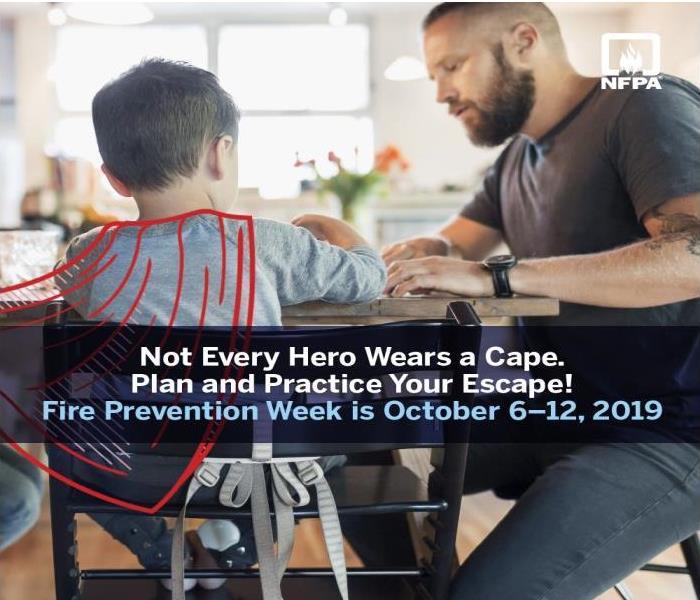NFPA Announces "Not Every Hero Wears a Cape. Plan Your Escape!" as the theme for Fire Prevention Week
10/9/2019 (Permalink)
 The most important aspect of fire prevention lies in awareness. Youngsters should be educated in smoke and fire safety.
The most important aspect of fire prevention lies in awareness. Youngsters should be educated in smoke and fire safety.
The National Fire Protection Association (NFPA) has announced “Not Every Hero Wears a Cape. Plan and Practice Your Escape!” as the theme for Fire Prevention Week, October 6-12, 2019.
This year’s campaign recognizes the everyday people who motivate their households to develop and practice a home fire escape plan; these seemingly basic behaviors can have life-saving impact.
“Not Every Hero Wears a Cape. Plan and Practice Your Escape!” focuses on what a home escape plan entails and the value of practicing it. These messages are more important than ever, particularly because today’s homes burn faster than ever. Synthetic fibers used in modern home furnishings, along with the fact that newer homes tend to be built with more open spaces and unprotected lightweight construction, are contributing factors to the increased burn rate.
A home escape plan includes working smoke alarms on every level of the home, in every bedroom, and near all sleeping areas. It also includes two ways out of every room, usually a door and a window, with a clear path to an outside meeting place (like a tree, light pole or mailbox) that’s a safe distance from the home. Home escape plans should be practiced twice a year by all members of the household.
Home Fire Escape Planning and Practice Home fire escape planning and drills are an essential part of fire safety. A home fire escape plan needs to be developed and practiced before a fire strikes.
Home fire escape planning should include the following:
• Drawing a map of each level of the home, showing all doors and windows
• Going to each room and pointing to the two ways out
• Making sure someone will help children, older adults, and people with disabilities wake up and get out
• Teaching children how to escape on their own in case you cannot help them
• Establishing a meeting place outside and away from the home where everyone can meet after exiting
• Having properly installed and maintained smoke alarms
• Home fire escape practice should include the following:
• Pushing the smoke alarm button to start the drill
• Practicing what to do in case there is smoke: Get low and go. Get out fast.
• Practicing using different ways out and closing doors behind you as you leave
• Never going back for people, pets, or things
• Going to your outdoor meeting place
• Calling 9-1-1 or the local emergency number from a cell phone or a neighbor’s phone
Smoke Alarms
• Smoke alarms detect and alert people to a fire in the early stages. Smoke alarms can mean the difference between life and death in a fire.
• Working smoke alarms cut the risk of dying in a home fire in half.
• Install smoke alarms in every sleeping room, outside each separate sleeping area, and on every level of the home, including the basement. • Test smoke alarms at least once a month using the test button.
• Make sure everyone in the home understands the sound of the smoke alarm and knows how to respond.
If a wildfire is threatening your home:
• Create a plan for evacuation that includes alternate routes out of the danger area.
• Have prepacked kits with essentials such as medicine, family records, credit cards, a change of clothing, and food and water.
• Create a family communication plan that designates an out-of-area friend or relative as a point of contact to act as a single source of communication.
• Prepare a plan for the care of pets and other animals.
• Sign up for wildfire alerts.
• Take steps to protect family, friends, or neighbors who have disabilities.
• Stay aware of local fire conditions. When told to evacuate, go promptly. If you feel unsafe, do not wait for an evacuation order—leave immediately.
A special note must be made about the elderly. The U.S. Fire Administration has found that seniors, while making up only 14 percent of the population as a whole, account for 38 percent of all fire-related fatalities. If you have an aged person living in your residence, see to it that he or she has eyeglasses, hearing aids and other necessary devices within arm’s reach while sleeping. Move all bulky furniture that could interfere with an escape from the building. And never leave heated blankets or other electronic equipment on for so long that it could catch fire.
About Fire Prevention Week
NFPA has been the official sponsor of Fire Prevention Week since 1922. According to the National Archives and Records Administration's Library Information Center, Fire Prevention Week is the longest running public health and safety observance on record. The President of the United States has signed a proclamation declaring a national observance during that week every year since 1925. Visit www.firepreventionweek.org for more safety information.
For more information about Fire Prevention Week and “Not Every Hero Wears a Cape. Plan and Practice Your Escape!,”along with a wealth of resources to help promote the campaign locally, visit fpw.org.






 24/7 Emergency Service
24/7 Emergency Service